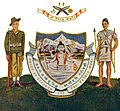| Emblem of Nepal | |
|---|---|
 | |
| Armiger | |
| Adopted | 28 May 2008 (Modified in 2020) |
| Motto | जननी जन्मभूमिश्च स्वर्गादपि गरीयसी "Mother and Motherland are greater than Heaven" |
The Emblem of Nepal is the national emblem of Nepal and is used by the Government of Nepal and many government agencies. On 13 June 2020, the emblem was revised to include the newly issued map which includes Nepalese claims to the Kalapani territory and Lipulekh Pass.[1]
Features
[edit]It contains the flag of Nepal, Mount Everest, green hills symbolising the hilly regions of Nepal and yellow colour symbolising the fertile Terai region, male and female hands joining to symbolise gender equality, and a garland of Rhododendron (the national flower) also called Lali Guransh (लाली गुराँश). Atop this is a white silhouette in the shape of Nepal.
Motto
[edit]At the base of the design a red scroll carries the national motto in Sanskrit: जननी जन्मभूमिश्च स्वर्गादपी गरीयसी (jananī janmabhūmiśca svargādapi garīyasī), which translates as "Mother and Motherland are greater than heaven."[2]
The phrase:
- अपि स्वर्णमयी लंका न मे लक्ष्मण रोचते ।
- जननी जन्मभूमिश्च स्वर्गादपि गरीयसी ।।
In English:
- I care not for Lanka, Lakshmana, even though it be made of gold.
- One's mother and one's native land are worth more even than heaven.
It was quoted by Rama when his brother Lakshmana expresses desire to stay back in Lanka.
Historical arms
[edit]Before 28 May 2008, the modern emblem was preceded by a coat of arms (actually an arms of dominion technically of the monarch), generally consisting of a white cow, a green pheasant (Himalayan monal), two Gurkha soldiers (one carrying a kukri and a bow, and the other a rifle), peaks of the Himalayas, two crossed Nepalese flags and kukris, the footprints of Gorakhnath (the guardian deity of the Gurkhas) and the royal headdress. It also contained the same red scroll with the national motto. From 1935 to 1962, the arms also bore the secondary Latin motto, "Dulce et decorum est pro patria mori".
-
Coat of arms of the Kingdom of Nepal (1935)
-
Coat of arms of the Kingdom of Nepal (1935–1946)
-
Coat of arms of the Kingdom of Nepal (1946–1962)
-
Coat of arms of the Kingdom of Nepal (1962–2008)
-
Emblem of Nepal (2008-2020)
Subnational emblems
[edit]Nepal is divided into seven provinces, each of which have adopted a distinctive emblem.
See also
[edit]References
[edit]- ^ Adhikari, Priyanka (2020-06-13). "Nepal gets a new political map, Coat of Arms". The Himalayan Times. Retrieved 2022-01-04.
- ^ People's Daily Online – Nepal to change new coat of arms
External links
[edit]- Infos at indianest.com (archived 17 March 2006)
 Media related to Coats of arms of Nepal at Wikimedia Commons
Media related to Coats of arms of Nepal at Wikimedia Commons





Well, that’s interesting to know that Psilotum nudum are known as whisk ferns. Psilotum nudum is the commoner species of the two. While the P. flaccidum is a rare species and is found in the tropical islands. Both the species are usually epiphytic in habit and grow upon tree ferns. These species may also be terrestrial and grow in humus or in the crevices of the rocks.
View the detailed Guide of Psilotum nudum: Detailed Study Of Psilotum Nudum (Whisk Fern), Classification, Anatomy, Reproduction